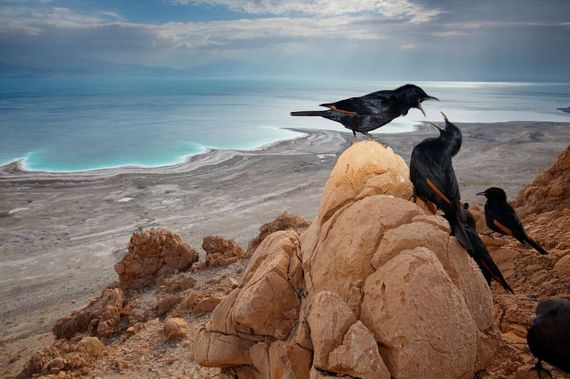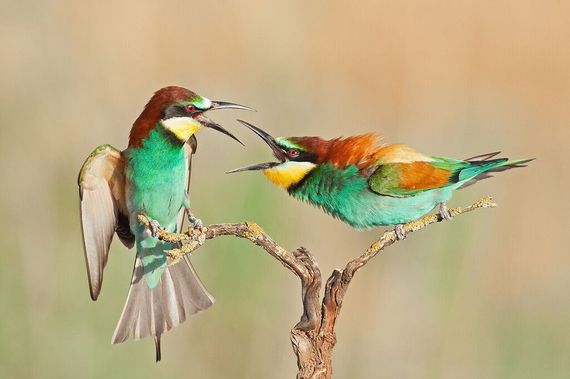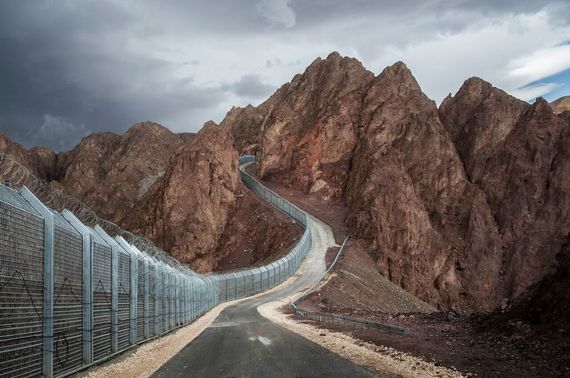Eretz Israel Museum Tel-Aviv is currently presenting two exhibitions of nature photography.
The Natural History Museum, London owns one of them, called Wildlife Photographer of the Year. This prestigious international wildlife exhibition started in 1964, and is held annually. 42,000 photographs from 96 countries were submitted to the 2016 international competition; only 100 of them were selected for the exhibition.
The competition includes a wide range of categories, such as "birds," "amphibians," "fish," "in the sky," "plants" and "urban." Millions of people from various countries come to visit this touring exhibition every year. After exhibiting the photographs throughout the UK, the exhibition hits the road. The 2015-2016 exhibition is scheduled to be displayed in no less than 35 other locations around the world.
The 2015 photograph of the year, "A Tale of Two Foxes", relates to global warming, depicting a common fox devouring a snow fox.
The second exhibition currently on display at the Museum Tel-Aviv is called Photo of Nature; it is a local exhibition alongside the international one. In its third year, this local exhibition presents the winning photographs in the Israeli nature photographers' competition. Of the 4000 photographs submitted to the competition, 90 were chosen to exhibit. It presents photographs and videos of wildlife in Israel, the way they live in their natural habitat and the beauty of the Israel's unique natural landscape. Categories inlcude "landscape," "nightlife of wildlife," and "social life in the underwater world." the way they live in their natural habitat"
The 2015 photograph of the year was of the friendly and melodious Tristrams' Starling birds atop a cliff above the ever-drying Dead Sea. It depicts the impact of people on nature, including wildlife.
Israelis cannot walk or drive to a neighboring country; they have to fly in order to tour another country. Israelis love nature. It is estimated that in one of the holidays this year 2 million Israelis travelled in Israel -- an impressive number for a country with about 8.5 million residents.
"A picture is worth a thousand words" - here are some of the pictures displayed in the 2016 local exhibition of Israel Photo of Nature. I thank the Eretz Israel Museum Tel-Aviv for providing me with the photographs and their descriptions, and giving me their permission to publish them here.
Photograph of the year
Ilia Shalamaev
Tristram's starlings on top of a rock, on a cliff overlooking the Dead Sea. The Tristram's starlings are not afraid of people, so I was able to get close to them and take pictures from a short distance.
The Tristram's starlings are very social birds with diverse and pleasant calls. They eat fruits of desert plants and parasites, which they pick from the fur of Nubian ibexes, donkeys and camels. During the past several years, the Tristram's starlings have learned to reach the parking lots at Ein Gedi and Masada in order to pick the insects, which are trapped in the front 'grille' of the parking vehicles.
Urban nature, 1st place
Eli Basri
Coexistence in an urban environment: a golden jackal near a hiking trail in the Yarkon Park, during the morning hours.
The golden jackals, who have lived in the Yarkon Park in the past several years, have grown accustomed to the company of human beings. Sometimes the jackals leave the park and wonder among the nearby neighborhood homes, scavenging for food in the dumpsters, creating a nuisance for the residents. As the night falls, their howls can be heard carrying over a great distance.
Yarkon Park, Tel Aviv, 25 July 2013

Photographic series, curator's choice
Roy Avraham
Shoham, April-May 2014
A pair of bee-eaters in a variety of situations: courtship feeding, in which the male feeds the female bees and other insects (after taking the sting out of the bees); battles with other male bee-eaters over the right to use the branch; and the act of copulation itself. The series was photographed from within a vehicle, which was covered by a cameo net and used as a hiding place.
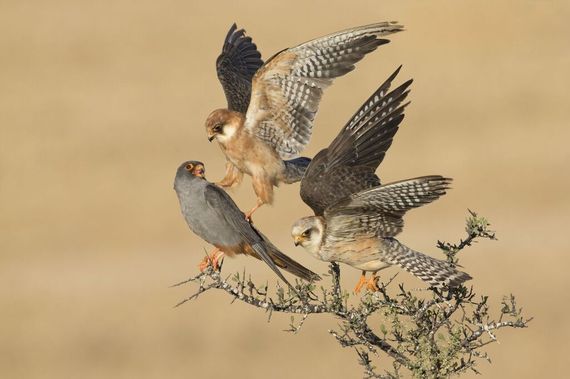
1st prize - BIRDS- Wildlife Photographer of The Year London's Museum of Natural History and the- BBC.
Amir Ben-Dov
ISRAEL
Red-footed falcons are social birds, migrating in large flocks from central and eastern Europe to southern and southwestern Africa. The closest relationships seem to be pairs or parents with first-year chicks, but otherwise, they maintain a degree of personal space. But these three red-footed falcons were different. Amir spent six days watching them on agricultural land near Beit Shemesh, Israel, where their flock was resting on autumn migration, refueling on insects. What fascinated him was the fact that two sub-adult females and the full grown, slate-grey male were spending most of their time together, the two females often in close physical contact, preening and touching each other. They would also hunt together from a post rather than using the more normal hovering technique. As so often happens in photography, it was on the last day in the last hour before he had to return home when the magic happened. The sun came out, the three birds perched together, and a subtle interaction took place: one female nudged the male with her talon as she flew up to make space on the branch for the other female. Exactly what the relationship was between the three birds remains a mystery.

57_DANIELWINTER-22.jpg
Conflict between man and nature, curator's choice
Daniel Winter
Shades of pink, green, and white in one of the pisciculture ponds at Kibbutz Nahsholim. The source of these colors could be algal bloom, dried up salt, or other factors. It is impossible to know from the photograph.
Kibbutz Nahsholim, Hof HaCarmel, 12 August 2014
Conflict between man and nature, 1st place
Tomer Ofri
The new border fence between Israel and Egypt creates a new reality, which influences, among the rest, the area's wildlife.
Nahal Gishron is the most southern canyon descending from the Eilat Mountains to the Gulf of Eilat, and is famous for its high granite cliffs. In the past, it was permitted to travel in the area, but following the security situation, some parts of it have been closed and bracketed with iron fences.
Nahal Gishron, Eilat Mountains, 8 May 2014
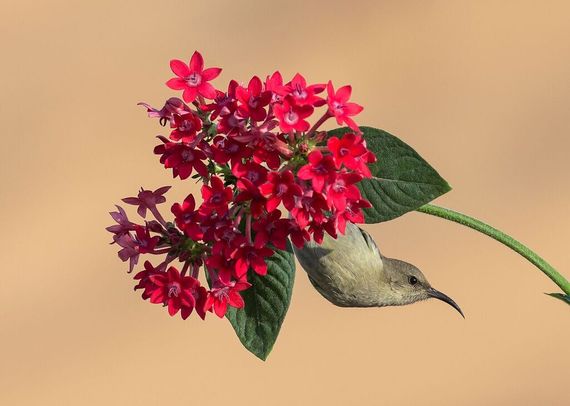
Birds, curator's choice
Aharon Shimshon
A female Palestine sunbird stands on a Pentas plant. The sunbird feeds off the nectar of flowers. Its long beak, which curves downwards, is adapted to extract nectar from flowers with very long calyxes .
The Palestine sunbird is among the smallest birds in Israel. The female is much less bright than the male, who shines in metallic blue-green colors.
Cliff Beach, Tel Aviv, 20 November 2013
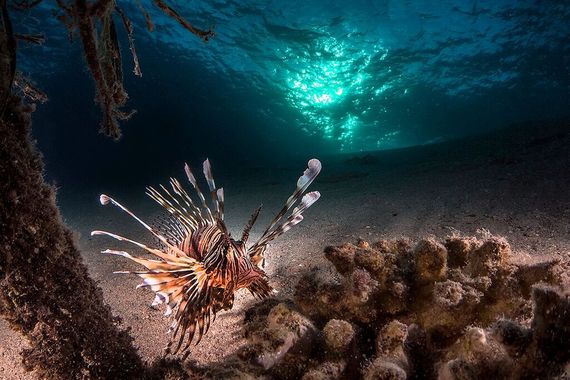
Underwater world, 1st place
Rafi Amar
A common lionfish in a moment of rest, against the background of the sandy slope, which is located between two diving sites in Eilat - Satil Wreck Site and Yatush Site. The sun adds a dimension of depth to the photograph.
The beautiful and flamboyant colors of the lionfish are warning colors. The fish's fin spines are rich with venom, which causes skin burns, breathing difficulties, high fever and sometimes even localized edema.
Between Yatush Site and Satil Wreck Site, 10 November 2013
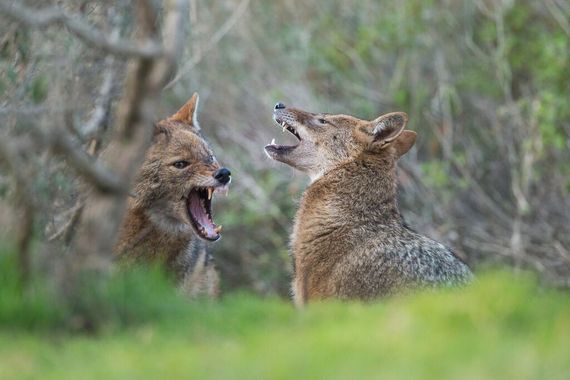
Photographic series, 1st place
Efi Cohen
A family of jackals I met while walking from my home in Nataf, in the Judean Mountains, to Ein Nataf Spring, which is located at the foothills of the settlement. For two years, I studied their walking trails and activity hours. I made myself a hiding spot between the bushes, with a cameo net and branches, and in this manner spent many hours, for several weeks. At first, the jackals sensed my presence and were suspicious, but with time they grew accustomed to me and allowed me to take pictures of them.
Nataf, Judean Mountains, December 2015
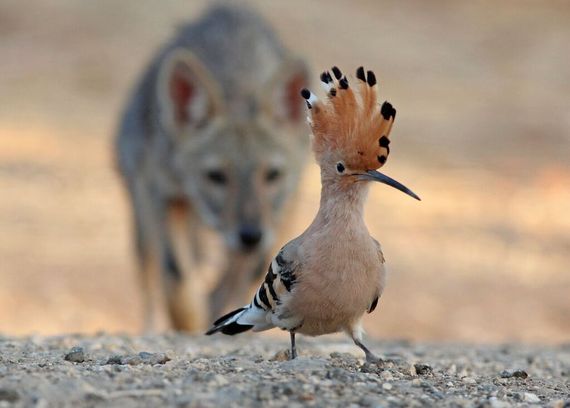
- Irit Drob
A young golden jackal - a member of a family of jackals that I have been photographing over the last two and a half years - ambushing a hoopoe. The encounter between the two had a happy end - at least for the hoopoe.
The hoopoe, which has been honored with the title of "the national bird of Israel", is common throughout the country, mainly in populated areas. It frequents irrigated lawns, where it finds its food - worms, insects and sometimes even small reptiles. The tuft of feathers on its head makes it easy to identify.
Yarkon Park, 4 August 2014

